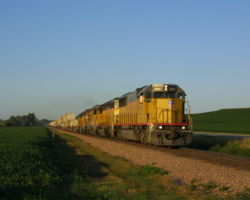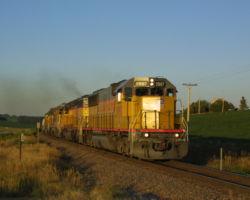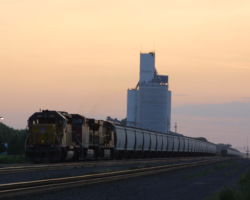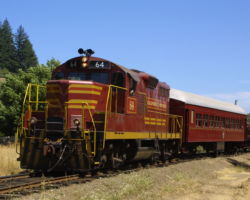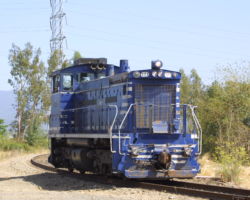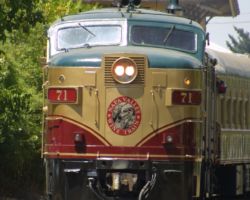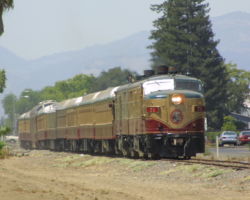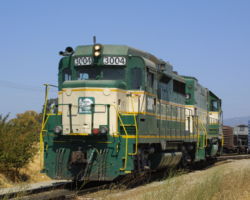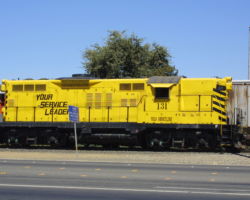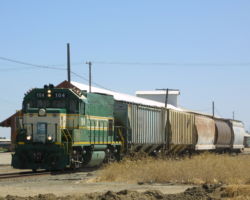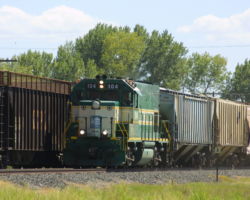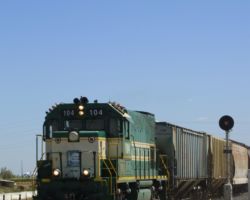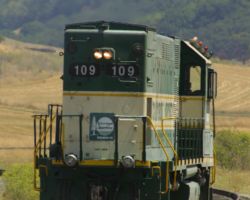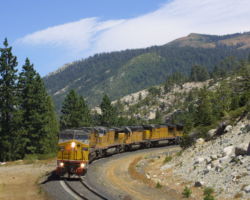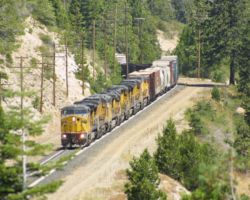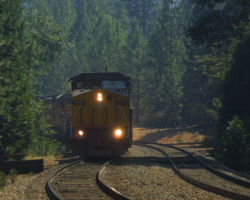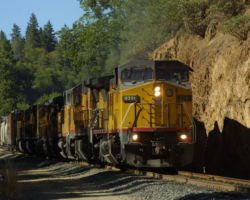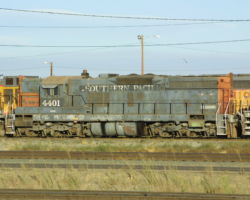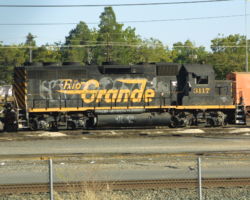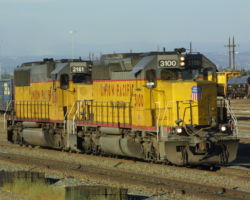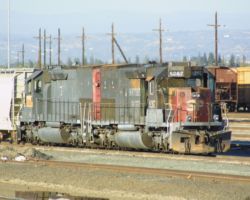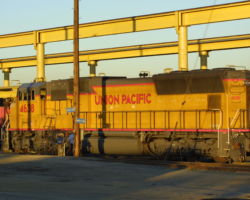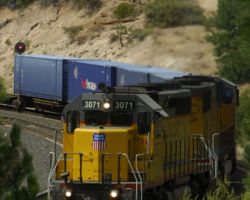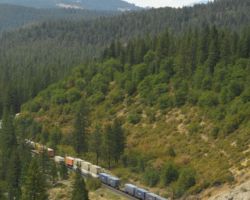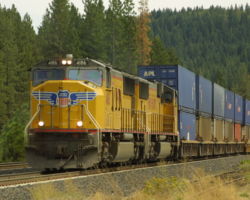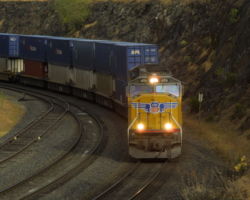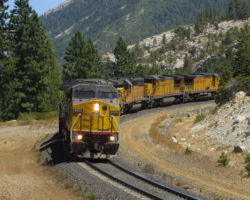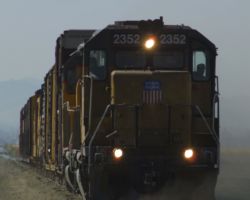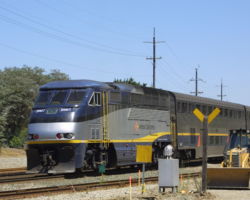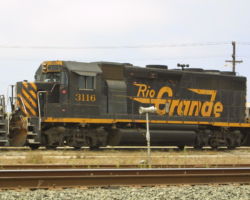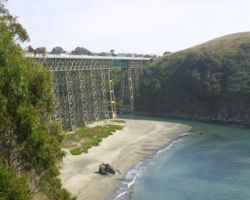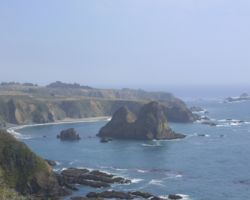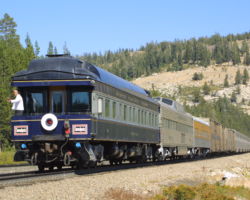But First, Back to Iowa… Aug 10-12, 2001
“What?” you’re thinking, “I thought this was a California trip report – what on earth are we doing in Iowa?” Well, it just so happens that the Saturday before I had to be in California, one of my college roommates was getting married, and as such I was drafted as a groomsman. Guess it’s payback for putting him in my wedding back in May…
Because of the highly compressed time frame (leave after work on Thursday, rehearsal dinner on Friday, wedding Saturday afternoon, and back in Colorado Springs by Sunday morning to catch my flight out), I didn’t get a great deal of time for railfanning. Because I made Thursday night a long one, though (stopped in Grand Island, NE, about 0100h on Friday morning), I did have time to leasurely work my way between Omaha and Carroll, IA (my destination). I’d spent many weekends out along the ex-CNW main in college, and rather missed the long, straight stretches through fields that Iowa provides.
The morning started by jumping on I-80 from Grand Island over to Omaha – I’d railfanned the section along US 30 east of Grand Island several times, never with much luck. It wasn’t as much an issue of trains, but rather the speeds at which they moved and the relative lack of warning you get while driving through here. In addition, I wanted to make it over to the Iowa Interstate shops before the sun got too high in the sky.
The Council Bluffs IAIS shops were more or less a bust for the day – there were only three units sitting around. IAIS 485 (in a not-quite done all-black scheme) and IAIS 481 (missing its main generator) were actually sitting near the shops, and one of the M420s was out switching cars around out in the yard. Unfortunately, due to how railcars were scattered in the yard, it was almost impossible to get a clear shot of the M420 – no matter, I had plenty already.
From there, it was a bit north to the CN (ex-IC/CC) yards. As expected, one lone CN geep (CN 4033) was switching cars around the yard (Photo #1), just as when I’d come through in May. Unfortunately, DRGW 144, which had sat behind the roundhouse at the G Avenue crossing was long gone, but there was a westbound UP manifest sitting a few hundred yards up the line. With a little patience, UP 3017 and the two other trailing SD40-2s pulled up and across G Ave., headed most certainly for either the yard or the bridge over into Omaha itself. Three things of note on this train: it was entirely SD40-2 powered, and the second one was a CNW unit with fairly intact paint. Finally, and probably most amazingly, all three units were ex-CNW! (Photo #2)
From there, it was up to Missouri Valley, IA. MV has changed a bit since I was last there – US 30 now crosses the mainline on a bridge, and the road that used to go across the west end of the yard has been truncated short of the crossing. Still, it was the end of double track territory headed west (until Fremont, NE), and also also a crew change point. Usually with a little waiting, I would find an eastbound ready to depart town, but not today. After eating lunch and even waiting a bit beyond that, I decided to give up and just head out along US 30, taking my chances with whatever showed up.
The first train didn’t show until almost twenty miles down the road, just west of Woodbine and just in time for me to catch it at one of my favorite spots. About four miles west of Woodbine on US 30, there’s an intersection with what I believe is called Parker Trail Road. If you take this to where it crosses the UP mains, and then turn right on to Perry Trail Road and follow it for about two miles, you’ll come to a hill overlooking a sweeping curve in the UP double track. Just as I reached the hill, I saw headlights come around the bend in the distance, and within minutes he was in position for the shot (Photo #3) and then gone. Stackers don’t waste much time out here, considering for the most part the track is only a few years old and in very good shape.
From here, it was on in to Carroll, IA. Other than this one stacker, and an empty coal train that got away from me, there wasn’t any traffic on the line. Later in the evening, while sitting out in the park in Glidden, IA, I could hear quite a few passing, but by then it was long since dark and I had other things to attend to.
The drive back was just about as interesting. The wedding was done at 1500h on Saturday (11-Aug-2001), pictures were done by 1600h, and after the initial bit of the reception I was out of my tux and on the road by 1630h. After all, I had to be ready to fly out of Colorado Springs in less than 24 hours (it’s an 11 hour trip, straight through, for reference, and I wanted a few hours at home before leaving). Just as on the eastward trip the day before, there was absolutely nothing for the first hour or so out of Carroll. Just short of Missouri Valley, I saw the tail end of an auto rack slowing, and as expected they stopped for a crew change east of the Ninth Street crossing. (Photo #4) I’ve always liked this shot for catching westbounds in the late evening, and it was good to get at least one more shot here (not that it’s going away any time soon, at least to my knowledge, it’s just that I don’t get as many opportunities as I used to).
Leaving Missouri Valley for points west on US 30 (had reservations in Kearney, NE, for the night, and didn’t feel the need to use I-80), I saw the tail end of a stack train just west of town. Passing over the river nearly pacing the power, I fell behind him again driving through Blair, NE. Given that you’re almost equal to a train going into Blair, though, you’ll more than beat him by the time US 30 rejoins the tracks near Kennard, NE. I’m not sure whether it’s due to grade or just speed restrictions, but westbounds don’t make very good time through this stretch – this one especially so, as it felt as if I waited forever at this grade crossing just east of Kennard (Photo #5).
With the sun rapidly falling towards a low cloud bank, I decided to try for one more shot before continuing the drive west. Near Arlington, NE, is a grade crossing just west of a bend in the line. I’d found it to be a good location several years earlier when chasing Alaska SD70Ms 4005 and 4006 west from Ames, IA, and it seemed a shot that should work now. After only beating him to the crossing by a minute or so, the resulting shot became Photo #6.
And so the day came to a close, without much traffic. Long after the sun itself had disappeared but the sky still glowed with the remnants of a sunset, I ran across a stopped grain train along the UP mainline west of Fremont, NE. I couldn’t resist – the colors and such were just too good. Out of nearly 40 shots, Photo #7 was the one I felt worked out best under reasonably challenging conditions (for a handheld shot – no tripod available…). From there, it was full speed to Kearney for the night, and then back to Colorado Springs to begin the real trip.
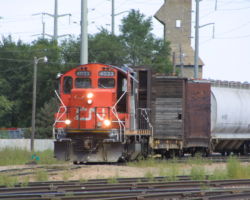
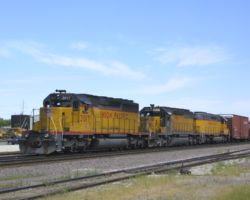
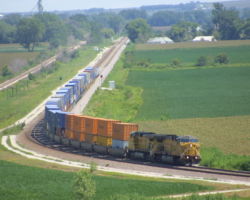
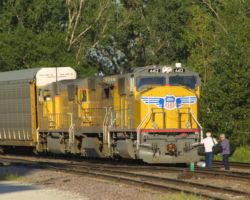
California Shortlines – The NWP, the NVRR, and the CWR
As promised, this trip report is going to be just a bit different. Normally I approach these things from a chronologic approach, with each chapter being a day or two in the trip. However, this time I chose to go with a different strategy, with one chapter devoted to each railroad, group of railroads, or in some cases, region, in only loose chronologic order. The logic behind this is that I didn’t cover particular sections or particular railroads on most days – it was really more of a shotgun approach (hit all the railroads in the area, see what turns up, pick the best and follow it). This was largely due to the nature of the area, which I think you’ll understand better later on.
I actually arrived in San Francisco (at SFO) about 1900h, and by the time I’d collected my luggage and rounded up a rental car (a white Ford Escape this time, rather than the micro-mini sub-compacts corporate travel typically sticks me with), it was well after 2100h. At that, it was off into the California freeway madness and north to Santa Rosa, where I’d be working for the next ten days.
Until the week before, I’d thought I’d be going back to Vancouver, so I didn’t have much time to research railfanning around the Bay Area, let alone even dig up a detailed rail map (or one of Altamont Press’ California Timetables, for that matter). The advice I had gotten was helpful, but not necessarily encouraging – mainly that railfanning the area is challenging at best due to a lack of accessibility, low traffic density, and the generally large distances between locations. Worse yet, none of the maps I did have showed a railway even close to Santa Rosa – the nearest thing was out of Napa Junction, some thirty-ish miles away. Things were definitely not looking up… An initial visit to the Santa Rosa facility where I’d be working revealed a railway, though rather dead-looking, so I went back and did a bit more research on the net that night to try to get a better handle on where I was going to be for the next two weeks.
First, a few basics on the region. To help those unfamiliar with the region, I’ve included a map as Photo #8 roughly showing the major lines in the Sonoma/Napa Valley area. The Northwestern Pacific runs south from its junction with the California Northern at Schellville (about halfway between Napa and Petaluma on California Hwy 12/116) to the swing bridge at Black Point and eventually to a junction with the NWP mainline at Ignacio. At this point, it turns north again, roughly following Hwy. 101 to Petaluma, where the current base of operations is located in the old depot (Photo #9). From Petaluma to Eureka, the NWP mainline still roughly follows Hwy 101, but is embargoed due to all manner of problems, including landslides and FRA defects.
Currently, the NWP is operating everything between Petaluma and the California Northern (CFNR) connection, and are working on getting the line restored as far as Willits for interchange with the California Western. Evidently there’s some lumber traffic that used to come off the CWR and down the NWP, but is now being trucked to a transload point – that’s the incentive to get this section of the line back in operation. As I was out there, there was evidence of work on the line, and apparently the FRA has since looked it over, but no trains have yet operated. At the moment, the only thing that the CWR is moving is the Skunk Train (a tourist hauler) between Fort Bragg and Willits. I caught up with this classy-looking train just outside of Willits on Monday, 20-Aug-2001 (Photo #10).
The Northwestern Pacific, while in the process of making a comeback from a complete FRA-mandated shutdown, it still seems rather like a ghost railroad. In several places about the system, dead or stored power is parked on sidings. Nowhere is this more evident than at Schellville, where at least two SD9s and several F units await reactivation or scrapping (Photo #11), along with several piles of remnants from scrapped locomotives (such as a pile of six-axle EMD truck frames). At Petaluma, there’s also an ex-SP / ex-North Coat Railroad GP9 that’s awaiting something just a few feet from the two bright blue SD40s (Photo #12). It seems to be that a California Northern train will bring over cars to Schellville for interchange in the late morning or early afternoon, where an NWP SW1500 takes them back and services the customers on the active part of the line. (Photo #13)
The other small railroad north of the Bay Area is of course the Napa Valley Railroad, running north from Napa to St. Helena and through the heart of wine country. While not a freight road (at least that I know of), the line sees multiple runs of the well-known Napa Valley Wine Train daily behind two of its four FPA-4s. On Friday, 17-Aug-2001, I drove over from Santa Rosa to St. Helena, and just happened upon the train south of town. In addition to the joy of watching the train pull northwards into St. Helena, I also got the pleasure of seeing the NVR railroad police pull over someone zipping around the gates on California 29. The RR police car seemed to follow the train fairly closely to the major grade crossings – I’m not sure if they have many problems, but he seemed to recognize that I was just a railfan and kindly left me alone.
The train pulled into the station and siding at St. Helena, where the power is run around the train for the return journey. For this particular trip, NVR 70 and 71 were on front, coupled back-to-back for obvious reasons. After a rather lengthy stop in obnoxious heat (I believe it was 95+ degrees that day), the train finally got underway for the return trip (Photo #14). Due to the 10 MPH speed limit on the whole line and the fact the tracks parallel California 29 almost the whole way between St. Helena and Napa, railfanning is almost too easy. The main problem is the heat rising from the almost desert-like ground – the heat waves really tend to foul up telephoto shots. Still, I got Photo #15 to work out just south of Oakville, CA. There are quite a few possible photo locations along the line – the real catch is picking out one particular one. Of course, if you’re not happy with it, it’s not exactly hard to get ahead a pick again.
That’s the three smaller railroads that run around north of the Bay Area. As you can see, none of them are big freight haulers, at least at the moment, but hopefully that will change in the near future. Don’t dispair for railfanning opportunities, though, because I haven’t even touched on the most interesting road of all – the California Northern. In some ways its a regional, but it operates more like a short line. In the next chapter, it’ll get the whole section to itself that it really deserves.
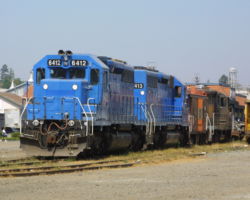
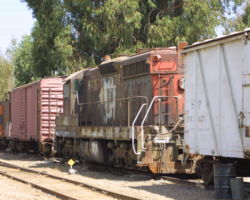
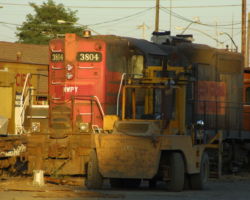
The California Northern
By far the most interesting and active railroad north of the Bay Area is the California Northern. This piece of the CFNR consists of four spokes coming out of their hub, located at American Canyon, CA. The first arm goes west to Schellville (MP72.5) for interchange with the NWP, and is appropriately known as the west end of the Schellville Sub (MP61.4 – MP72.5). Once it leaves the American Canyon / Napa Junction area (MP61.4), this line is basically inaccessible until almost reaches Schellville. The east end of the Schellville sub (MP61.4 – MP 48.5) extends from Napa Junction to Suisun City, where the CFNR interchanges with the Union Pacific’s Martinez Sub. The third arm is known as the Napa Sub, and extends north from Napa Junction to Napa, CA, where it interchanges with the Napa Valley Railroad. Extending south from Napa Junction to Vallejo is the fourth arm, known, not surprisingly, as the Vallejo Sub. None of these lines have a high speed limit, and all operate with a frequently-used road frequency of 161.385 MHz, making railfanning relatively easy. Jobs operate on all four legs most weekdays (and some on Saturdays, I understand), and are usually very easy to locate.
For power, the CFNR mainly uses a fleet of ex-CNW GP15s, otherwise affectionately known as “Culvert Motors” to us tunnel motor fans that grew up in the Midwest instead of the Mountain West. Also mixed in the pool while I was there was GP30 #3004 from the CFNR’s sister road, the Arizona and California Railroad. The power seems to be based out of an enginehouse at Napa Junction / American Canyon, set a little ways east of California 29 headed into Vallejo. As a note, I’ve also read that the power that runs on the east end of the Schellville Sub (Suisun City to Napa Junction) ties down at the east end at Busch (the siding for the big Budweiser brewery by Cordelia), not at Napa Junction, and then works into NJ in the morning with a load of interchange traffic. In the afternoon, they supposedly work back. I actually wasn’t around enough to confirm this, but based on the trains I did see it would seem accurate.
Very few weekdays went by where I didn’t drive over to Napa Junction to watch California Northern operations, if for no other reason than I was almost certain to catch something. That’s aside from my opinion that groups of GP15s running around in CFNR’s great green and white scheme look absolutely great through a camera lens, and rumors that a change may be coming for the CFNR. As far as railfanning, until you figure out what a train and crew is doing, I found the best place to sit and watch to be around the California 29 overpass at Napa Junction. Both sides of the tracks are readily accessible, and it’s quick and easy to go any direction once you figure out what a crew is doing (Photo #16).
Certainly one of the important industries on the line is the Napa Pipe plant. This is the huge facility just north of the California Hwy 12/29 bridge just south of Napa itself. This plant turns sheet steel into pipe, presumably for natural gas service (I’d guess, anyway). Sheets are hauled in, cars of finished pipe are hauled out. On Wednesday, 15-Aug-2001, I caught CFNR 109 headed up the branch with a few cars, and about half an hour later returning to the yard as just light power (Photo #17). However, this was the only day I saw this particular move, but I’m told it runs regularly. Of interesting note is that 109 is a remote-control locomotive. It’s rather odd to see the engineer running the unit from the front porch rather than the cab, but with all the slow speeds, the light power movements, and the swealtering heat, I can certainly understand (Photo #18).
The line west out of Napa Junction over to the UP interchange at Suisun City also seems a good place to catch traffic. Usually these trains draw at least several units (three most of the time, four one day), and while I was there consistently drew AZRC GP30 #3004, along with CFNR 103 and 107. Seen in Photo #19 switching the Busch spur (which, I believe, services a Budweiser brewery), they’re preparing for Wednesday, 22-Aug-2001’s morning run of interchange traffic over to Napa Junction. Once they depart, it’s easy to catch them again at Cordelia (Photo #20), and then once again for a beautiful shot coming down into Napa Junction (Photo #21).
In addition to the operations centered around Napa Junction, the CFNR also runs the West Valley Subdivision between Davis and Tehama, CA, as well as the West Side Subdivision between Tracy and Los Banos, CA. All three pieces of the system are physically disconnected, but all interchange with Union Pacific. While I did drive by the CFNR interchange in Tracy, there wasn’t a good opportunity for a shot of the single GP15 sitting in the yard. The West Valley line I decided would make a good diversion on my way to the Feather River Canyon from Santa Rosa, though, and so I spent some time following it on Wednesday, 22-Aug-2001 (after getting side-tracked on following the local from Busch over to Napa Junction that morning).
The Davis – Tehama line isn’t at all hard to find – in fact, it pretty much runs right through downtown Woodland, CA, where I first picked it up. This is also where it interchanges with the Yolo Shortline, with its colorful geeps. (Photo #22). Following the line north partially using I-5 and partially using the frontage road, the first thing I actually saw was CFNR 104 stopped in Williams while I’m guessing the crew was off getting something to eat. (Photo #23) Note that, like 109 earlier, 104 is also a remote control unit with those odd little lights on the cab. Taking the opportunity, I dropped by the local McDonalds to grab some food myself, and this provided just enough delay – as I pulled out, 104 and train were headed north again.
After several grade crossing wedgies, I eventually began to tire of the line – if you’re looking for great scenery, the West Valley sub doesn’t even qualify. It’s straight, it’s flat, it’s boring – at least until you get to the last few miles into Tehama. Still, somewhere around what I’m guessing was Delavan, I found a siding full of interesting cars – old coal cars (mainly KCPL cars) with wire mesh extensions around the top. Since 104 and train weren’t too far back, I took some roster shots of the unusual cars (presumably beet carriers?) and then eventually got 104 passing the lineup. (Photo #24) After that, it was on to Oroville for the night and my last encounter with the California Northern.
For those wanting more information about the CFNR, I’d suggest either David Epling’s unofficial CFNR site or the official corporate site at Park Sierra Rail’s website (note: now defunct – the CFNR is owned by Gennessee & Wyoming). It’s truly a great not-so-little railroad to railfan, with lots of movement and very photogenic power, not to mention generally very friendly crewmembers (at least the ones I encountered).
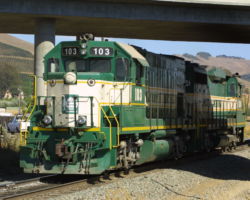
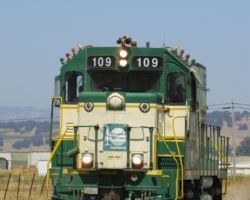
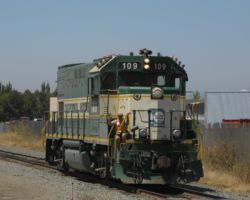
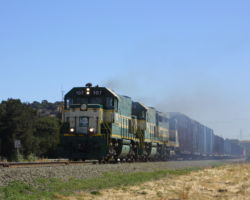
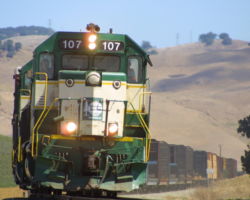
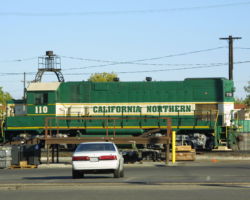
Donner Pass & UP’s Roseville Sub
Deciding that I could only do so many days of railfanning the various smaller roads near Santa Rosa, I decided to head out for Roseville and Donner Pass for my first Saturday out there. For reference, Roseville is probably 2 1/2 hours from Santa Rosa, assuming fairly normal traffic and you don’t get held up by distractions such the California Northern or, my personal favorite, In-N-Out Burger (for those who haven’t had one, you wouldn’t understand).
Donner is a different railfanning experience for the simple reason that you have to use the freeway (I-80) – there aren’t any side roads that follow the line the whole way. Even when there are side roads, in many places the railway is located in such difficult places that a road couldn’t follow it anyway. To make matters worse, during the week before the Emigrant Gap fire had been intermittantly closing UP and I-80, and while it had been dealt with, a new fire had started near Colfax. I actually arrived in Roseville around 1100h, and decided rather than exploring the yard at first, I’d head directly up into the mountains and find whatever there was to find rather than wait and have the smoke from the still-growing fire ruin any possible shots.
As things turned out, the drive up was quiet – no trains in sight, and the scanner wasn’t picking up a thing – just my luck. The drive did give me a quick chance to familiarize myself with the line, though, and wisely I followed a tip I’d gotten earlier to check out Alta. Upon arriving, I found a great curve and a small parking area beside the tracks, just perfect for something coming up the hill. For that matter, with enough creativity, westbounds headed down to Roseville might also work. Better yet, I was far enough east of the fire that the smoke wasn’t yet clouding the clear blue mountain skies. Still, there wasn’t any sign of a train to put in the shot…
The first sign of a train didn’t come until the summit itself. Once I’d actually come over the mountains and could hear the dispatcher on the radio talking to a M-o-W crew near Truckee, I was lucky enough to get a lineup for the day. Unfortunately, it wasn’t all I’d hoped for, but it was a start – two westbounds, two eastbounds. The westbounds were a mixed and a Z, the eastbounds were Amtrak #6 and another mixed. Also, apparently something had happeded to the westbound Z train – it had been delayed at the west end of Reno until a Special Agent could arrive and… (static – just when I didn’t need it).
Either way, I looked out across the valley (the view from Donner Pass Road just east of Norden is incredible) and to my surprise saw a string of cars moving along, high on the hillside. Well, that had to be the westbound manifest in question. I waited for a few minutes for it to emerge from one of the closer snowsheds, and when it didn’t I started to become a bit concerned. A look at the map confirmed what I’d feared – those snowsheds were the abandoned line; the current line tunnels under the whole area. Still, a quick trip back to Norden got me there ahead of the train, but not by much (Photo #26).
The next photo opportunity for westbounds after Norden is really at Soda Springs, just a few miles down the road. A little tip for those railfanning the area – you can’t beat a westbound from Norden to Soda (at least if you stay close to the speed limits), so forget it and start thinking further down the line. Because the grade clings high up on the hillside (whereas I-80 tends to follow a much lower course), the next easy shot for anything comes near Yuba Pass, at the junction of I-80 and CA Hwy 20. If you follow the interchange so you’re almost on the eastbound on-ramp to I-80, there’s an area to park off to the south side, and a great shot of westbounds coming around the curve just east of Shed 10. The other advantage of this spot is that it’s single track CTC here, so trains from both directions will pass through on the line (and nothing’s sneaking by where you can’t see it). However, with the steep grades, it does take quite a while for a train working down the hill to creep down from Soda Springs. I think I probably waited for close to 25-30 minutes before the rails started to squeal (the track makes plenty of noise before the train is actually visible here, giving a half-sleeping railfan plenty of time to wake up and remember to turn the camera on – Photo #27).
From here, I decided to give Emigrant Gap a try. There’s a rest area/brake check area off the freeway and high above west end of the single track section that started back by Yuba Pass, and so I thought I’d give it a try. I parked in the area and walked back down along the exit ramp (outside the guardrail most of the time), and lined things up just in time for 9391 to emerge from the cut through the hill and start working down along the ledge (Photo #28). From up here, if you crop the shot right, you’d never know that everything just to the right of this shot is a blackened, incinerated wasteland now due to the Emigrant Gap fire just a week before. In fact, while I was shooting this, a helicopter was still flying around, presumably looking for remaining hotspots.
The winds were picking up a bit, and by the time I was leaving Emigrant I noticed the smoke from the fire down around Colfax was starting to foul the air a bit, contributing a mild haze as well as a rather obnoxious tint to the light. Still, I decided that Alta would be my next best bet, so down the freeway I went, straight into more smoke and some very odd lighting conditions. Just east of the Alta exit, I saw Amtrak’s #6 (the eastbound California Zephyr) speeding along, right on schedule.
After waiting at Alta for what seemed like an eternity, 9391 finally appeared through the haze, down the line in a canyon of trees that had been steadily filling with smoke (Photo #29). Unfortunately, many of the shots on this line are similar to this – the train never really sees much light, but the scenery’s great! After a few minutes, the manifest’s rear distributed power cleared the crossing, and I snapped of Photo #30 before departing. The smoke was really rolling in at this point, assisted by a strong eastward wind over the mountains, and I was getting hungry, so I’d made up my mind to stop in Colfax for something resembling food.
Unfortunately, fate had other plans. As I passed over the line again near the Secret Town Road exit, I noticed a train under the bridge – the problem was that it was headed up, not down the hill. This would have to be the other eastbound manifest that I’d inferred from the dispatcher’s conversation earlier. So, with that, it was off and back on the freeway, headed back to Alta for another round – basically, back into the smoke. (Photo #31)
Now, it was time to head back to Colfax and grab something edible – I hadn’t eaten in about 24 hours, so I was more than a little hungry. With two fish sandwiches and a Coke in hand, I was off again to find our manifest in question. As it turns out, that wasn’t all that hard – as I came up on the Clipper Gap exit, I saw the back end of the manifest sitting in amongst the trees. While looking for the front end, I wandered back along the road, under the first main, and back to the grade crossing with the second. Sure enough, looking down the cut, UP 9391 was just sitting there, lights off, waiting for something. A few minutes listening to the scanner confirmed that it would be underway shortly – the distributed power units had lost communication and put the whole train in emergency, giving one of the crew members an opportunity to get his daily exercise by walking the train. Since I’d wasted so much time looking around Colfax and eating, he was almost back to the head end by the time I arrived.
The dispatcher was anxious to get them out of the way, since there was a Z train pulled right up behind them. Sure enough, within a few minutes, 9391 came through the cut (Photo #32) and eventually the trailing DPU disappeared around the curve (Photo #33). Shortly thereafter, more headlights showed up on the northeast end of the cut – the following Z! The plan, as I understood it, was to get everything moving and then allow the Z around at Newcastle, have his event recorder downloaded at the west end of Roseville, and head right on through, leaving the manifest plenty of time to plod down into the yard. I learned later that this Z, lead by UP 4342, had been involved in a grade crossing collision back in Reno, and that was the cause for all the discussion about a special agent on the radio earlier in the day. It must not have involved the locomotive, however, becuase 4342 didn’t show a single scrape when it came through.
After both had passed, I headed down to Newcastle with the hopes of catching them side-by-side. However, it didn’t quite work out – when I got there, UP4342 was already through the crossing, and 9391 was holding back behind a signal on the opposite side of the bridge over the freeway. Still, as soon as the Z had cleared, 9391 got the signal and was underway again. With that, I headed down into Roseville to check around the yard a bit.
I made one other trip to Donner the next Friday (24-Aug-2001), and more or less got skunked between Roseville, CA, and Reno, NV. To make a long story short, though, the only things moving were Amtrak’s #6 and a BNSF manifest train following along behind. Due to timing, neither really provided any good photo opportunities, but of particular note was a bit of private varnish tacked on the back of #6 – specifically Rio Grande’s Royal Gorge. (Photo #35) It’s amazing how far you can get from home, and Rio Grande equipment just keeps popping up…
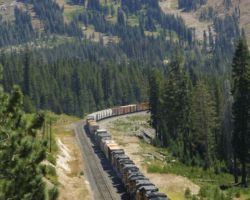
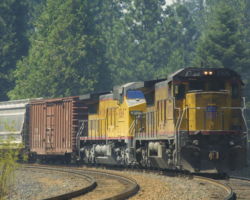
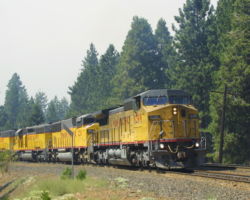
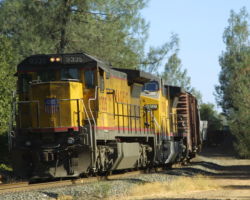
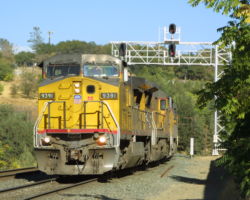
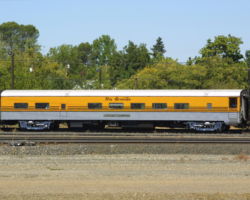
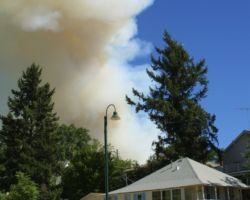
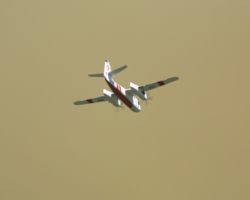
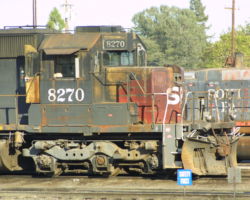
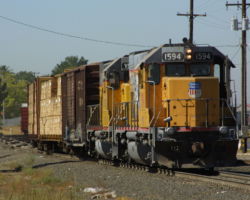
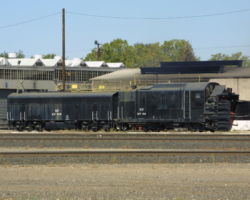
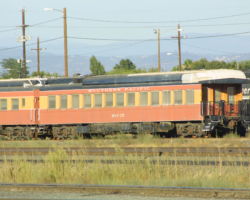
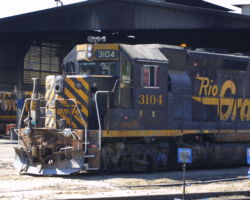
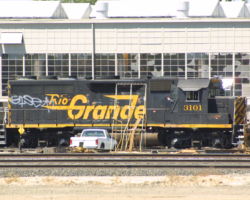
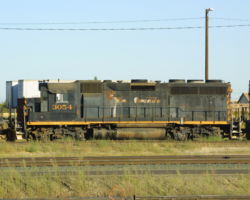
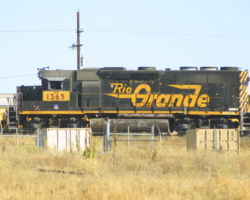
The Feather River Canyon – August 23, 2001
I’ve always wanted to visit the Feather River Canyon area – there’s something definitely fascinating about a railroad that seemed to have natural calamities every spring, and yet was valuable enough to keep rebuilding. Of course there’s also the added draw of the spectacular scenery and that wye at Keddie that seems to show up at least once a month in any rail magazine worth its price (and even more often in the ones that aren’t ;).
I actually stopped on Wednesday night in Yuba City, CA. Aside from the fact that I couldn’t seem to find motels/hotels in Oroville (close to the mouth of the Feather River Canyon (hereafter referred to as the FRC, so I don’t have to keep typing it), Yuba City also happens to have the distinction of being near Marysville, where the ex-WP line to the FRC and the ex-SP line towards Dunsmuir cross. Despite what would seem to be a near-ideal railfanning location, I didn’t have much luck catching trains around Marysville the night before. I was hoping this wasn’t indicative of traffic levels through the FRC – I’d been warned that traffic dropped dramatically on weekends, but hadn’t heard anything about track work, etc…
My morning started around 0800h in Yuba – still a bit early for me, but considering the half-hour drive north to even get to the FRC, not unreasonable. It was just for someone who’d been on the road for two weeks at this point still a bit early in the morning. For those who stay in Yuba and then head up to the FRC, be sure to take CA Hwy 99 north rather than the more direct route of CA Hwy 70 – this follows UP’s Valley Sub (ex-SP line) quite nicely between Yuba and Gridley, and if you’re lucky you might get a train in the morning light. As I said, though – you might get lucky, I didn’t – nothing but clear track for me.
The FRC line isn’t hard to find or follow – north and east out of Oroville, CA Hwy 70 follows the line reasonably closely the whole way. However, the first twenty-three miles aren’t quite original – they’re the result of a 1962 realignment around the area to be flooded by the Oroville Dam. Fortunately, though, that provided several very interesting shots, including a horseshoe at James where the road passes over the line and then passes over it again only a few hundred feet later – the railroad makes a giant loop off to the north to gain altitude. Probably the most impressive structure, though, is the West Branch Bridge, a combined road/rail bridge across one of the legs of Lake Oroville. The realigned ex-WP main sits on the bottom of a giant through-truss bridge, and the four-lane road deck sits on top. It’s something you won’t miss on the way up.
Eventually the road rejoins the railway at Pulga, with the famous dual bridges. I thought about stopping for a quick photograph, but I figured I’d get the shot later in the afternoon, once I’d actually found a train. I kept seeing various cars parked along the road, and each time I checked to see if there were any crazy people with cameras standing around it. Each time, though, it just turned out to be guys out in the river fishing away, almost oblivious to the railroad above them.
As it turns out, the first train wasn’t that far away – somewhere around Storrie I came up behind an eastbound Z train. Another few minutes and I’d arrived at Camp Rodgers about thirty seconds ahead of him, and there was a westbound grain train in the hole on the south side of the canyon. Within few seconds of grabbing the camera and jumping out of the car, another railfan had arrived (with a license plate like “WP FAN”, what else could he be?) and a westbound grain train came through. The only problem was that I’d have to follow him back down the canyon if I wanted a decent shot, as the morning light wasn’t hitting the south canyon wall at all.
Despite the fact the Altamont California Timetable lists speeds through the FRC as 25 MPH, it certainly didn’t seem like this guy was doing 25. Rather, it seemed more like 35-45 most of the time. I’m still wondering if UP hasn’t done so much trackwork through the canyon that they’ve been able to raise train speeds a bit, and the railfan community just hasn’t noticed the updates. My first opportunity for a shot on the right side of the canyon (which, in the mornings, is the north side) was between Storrie and Merlin on Rock Creek Trestle. (Photo #51)
The unfortunate part was that being unfamiliar with the canyon, I didn’t already have my spots picked out for photographs. Many times, when I’d see what I thought was a shot, I’d stop, check it out, and decide it wouldn’t work. When you’ve got a relatively fast train nipping at your heels the whole time, it makes the process all that much harder. Suffice to say I missed a few good ones, and shot a few bad ones between Camp Rodgers and Pulga (yes, I followed 6335 west clear back to Pulga). As a side note, though, one of the very few long clear spots along the line is just east of Pulga, down from the dam – if you’re looking for shots with much of the train in them, this is probably the place to go (Photo #52). Other than that, I didn’t find many places that the ugly, peeling lead SD60M looked good in, and in a place like this, that’s saying something.
After that, it was back up the road, hoping I’d catch another freight that had been pulled over to let the Z pass. Unfortunately, it wasn’t to be, and as I burst through a small cut, there it was – one of the great railfan Meccas of the world, the Keddie wye. What really surprised me was the sheer number of railfans out on a Thursday – while I realize they’re probably on vacation, same as I was, it was still rather surprising. Apparently there were work windows open for a crew between Keddie and Quincy Junction, and therefore any traffic was backed up on one side or the other. The good news out of all this was that I heard the dispatcher explicitly stating he wanted the line back at 1330h, so it was just a matter of waiting. The reason the DS wanted the line back at 1330h was an eastbound Z train that would be hitting Keddie right about then, and sure enough, with only a few minutes to go in the work window, UP 4599 creeped out of the tunnel and across the trestle (Photo #53).
One thing of note about the whole drive through the FRC – there aren’t gas stations. As much as I was getting attached to my little white Ford SUV-wannabe, I had one big complaint about it – the size of the gas tank. I’m used to 500 miles on a tank; this thing was lucky to get 240. When you’re railfanning in the middle of nowhere (okay, not quite, but close), it’s somewhat concerning as you keep seeing the gas needle edge lower as you have no idea where your next tankful is coming from. However, having spoken to some other railfans and found out there was a Taco Bell in Quincy, I had great faith that there would be gas, too. Since the line veers away from CA 70 between Keddie and Massack (on the west side of Quincy), I decided to use those few minutes before the work order lifted to stop for fuel. After that, the plan was to figure out how to shoot trains at Williams Loop, just west of Quincy, and catch up with one of the stackers again (either the one I’d just seen, or the one from earlier in the day that was stopped at Keddie as well).
The loop isn’t hard to find – the road runs over the main on the west side, and follows the loop track all the way around, plus there’s a large gap in the trees where eastbounds actually run west for a few hundred yards. With the sun getting well into the afternoon sky (and hazy clouds starting to block the direct light), I decided that this little clearing along CA 70 was my spot. Sure enough, moments later UP 3071 showed up with the first stack train I’d seen that morning (photo #54). While I assumed the other stacker would be following along behind (or I’d already missed it due to my gas stop, but I doubted that), I decided to press on and try some other locations. As it turns out, the first of these was only about 3/4 of a mile down the road, where a bend in the Spring Garden siding is visible through a break in the trees (Photo #55). Using the speed restriction on the loop to your advantage, it’s fairly easy to shoot both on the loop and here as well.
A bit further down the road, past Cromburg, I had one of those experiences where I looked over, and at 60 miles an hour realized I’d just missed the shot I wanted. Or at least the setting – I still had time to get back to the overlook before the train arrived. It’s a great view, but with the clouds now solidly filtering the light from the sun, the lighting of the scene was getting a bit strange. Still, I figured I was only going to get here this once in the forseeable future, so I might as well take the shot. The result became Photo #56, after a little digital correction on the coloration and sharpness.
It was indeed a good thing I stopped rather than pressing on, as I heard a train at Sloat giving a clean roll-by over the radio to 3071. At last, what I’d been waiting for – a westbound to follow home! I’d actually intended to make it out to Portola and visit the Portola Railroad Museum, but with the sun moving further into the western sky and the clouds building to the east, I decided I wouldn’t pass up the opportunity to get a train to follow back. I high-tailed it back to Sloat, just in time to see the second stacker (lead by 4599) breaking out of the trees eastbound. Sure enough, there was a westbound Z train sitting in the hole, led by UP 4168 and 4061. As soon as 4599 and train had passed, the lights on 4168 came on and the crew got the signal to proceed (Photo #57).
With a westbound following along, I could finally get the shot at Williams Loop that I really wanted – the traditional over/under shot, with the power on the train coming right at me (though vertically-separated by 25ish feet courtesy of the highway bridge). As noted in the caption, the real challenge here isn’t the train or the amount of zoom you’ll need for the shot, but rather just staying safely out of traffic. The bridge isn’t really built with walkways, so you’ll have to just use the wide curbs and be conscious of oncoming traffic. Still, it’s not that hazardous, and it does result in some outstanding shots (Photo #58 – which would be much better, aside from clouds screwing up the lighting – why blame the photographer when you can blame the weather instead?)
From here, it was a basic over-the-road railfanning trip the rest of the way back to Oroville, with one exception. Drive a bit, pick a shot, take it, repeat. After my trouble with finding spots earlier in the morning, I’d picked a few on the way up to Keddie that I intended to use. Some of them worked out, some of them didn’t. One of my favorites I believe was around Rich Bar, where the line snakes around some very open cliffs. (Photo #59) The only interruption in the trip came at Belden. I’d set up a shot west of Belden through some of the tunnels, and much to my surprise it wasn’t 4168 that showed up, but rather an eastbound BNSF mixed (lead by BNSF 5333, ATSF 924, and BN 3112, for your bean counters out there). Due to the delay of going in the hole, the light had faded far past usable by the time 4168 finally did show up. I clicked off a few, but none were really notable – I couldn’t figure out (under pressure) how to set up a good shot with these tunnels. I have a feeling the secret may be to try a bit further east in the canyon, where it’s a bit more open and the geometry is such you can get a shot almost straight at the east end of one of the bores.
Since I wasn’t going to get another opportunity, I decided to head back to Pulga and try for a shot of the train snaking through the bridge there. I wasn’t sure how much light I’d have by the time I arrived (especially considering how deep the canyon is at this point), or of what quality the light would be, but I figured it was at least worth a shot. After some waiting and a good deal of messing with the camera and lenses to get the best possible setup without compromising shutter speed and aperture too much, 4168 dutifully showed up and brought the stacker right into the shot – and quite slowly, too, thankfully. 480mm focal length, 1/250th of a second shutter speed, hand-held (no tripod, left it at home) in evening shade with a fast moving train wasn’t something I really wanted to think about. I really didn’t have any expectation that the shot would work out, but it came out surprisingly well considering the conditions (Photo #60).
Since the railway stays either away from the highway or in tunnels through a good part of the 1962 rerouting, I intended to catch it coming over the West Branch bridge. However, the lighting didn’t really cooperate, and I couldn’t find anywhere to put the car where I could walk back to the bridge in time. I decided to take my final shot for the day below the upper bridge at James where the line comes out of a cut and ducks under the roadway. Again, even though I was almost out of the mountains at this point, the sun was really starting to set, but I like the effect of the dark cut and the last evening light on the nose. (Photo #61) At that, I called it a very productive day and headed back for Yuba City and dinner.
My advice for anyone considering railfanning the Feather River Canyon – do it. If you like the scenery on the eastern part of the Rio Grande system, you’ll love the ex-WP line through the FRC. After all, it was the profits of the Grande that helped pay to build the thing (involuntarily, and at the cost of its own financial solvency, though). If you’re trying to chose between Donner and the FRC, take the FRC. Donner, while train movement is slow, and the scenery is definitely something to see once, is far too confusing and inaccessible for my tastes. The FRC, with its single track CTC main line, is very easy to understand as a newbie to the area, and had excellent accessibility to all the good shots right off the highway. Perhaps those who truly know Donner know how to get to areas that yield even better shots, but as someone new to the area, I sure as heck couldn’t figure it out in a couple days. Be sure if you do go, though, to take a scanner, your Altamont Press timetable, and plenty of film – or, if you’re like me, lots of hard disk space. Oh yes, and the biggest, best telephoto lens you can afford helps quite a bit, too.
I hope you’ve enjoyed it, or at least the photos if you’ve elected to skip reading the mindless drivel I write to go with them (Some days I’d like to skip writing it, so I wouldn’t blame you for skipping over it, too :). If you’re more familiar with the area than me, and find any bugs in accuracy, please let me know. I’m by no means an expert, and am writing this off my maps, notes, and photographs. Also, I’ve included one more section of photographs that didn’t really fit elsewhere – either because a section already had too many, because they aren’t really railroad-related, or because they were from days that didn’t yield enough for their own section. Thanks!
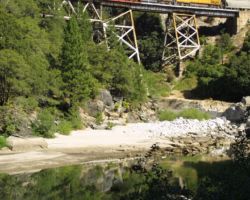
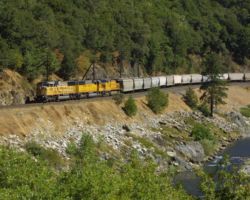
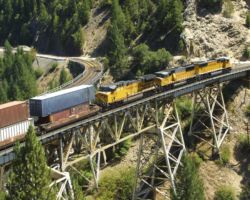
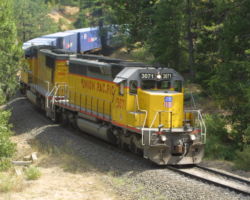
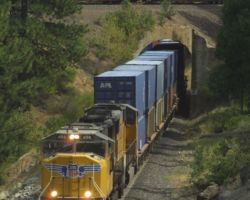
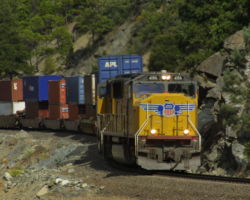
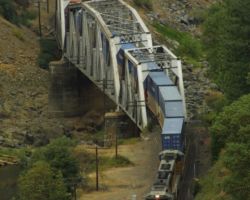
Miscellaneous Photos
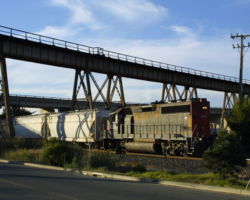
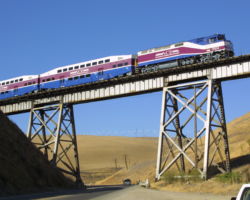
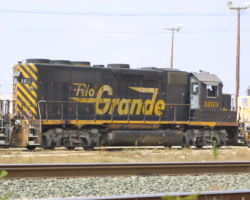
This work is copyright 2024 by Nathan D. Holmes, but all text and images are licensed and reusable under a Creative Commons Attribution-NonCommercial-ShareAlike license. Basically you’re welcome to use any of this as long as it’s not for commercial purposes, you credit me as the source, and you share any derivative works under the same license. I’d encourage others to consider similar licenses for their works.
